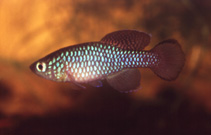| Diagnosis: |
Dorsal spines (total): 0-0; Dorsal soft rays (total): 13-15; Anal spines: 0-0; Anal soft rays: 14-16. Diagnosis: Nothobranchius krammeri can be distinguished from all other species of the genus by the following combination of unique characters: 13-15 dorsal fin rays; 14-15 anal fin rays; 24-27 scales in median lateral series, frontal squamation pattern variable, pelvic fin tips not reaching the anus, male body and head scales light blue with pale red to pale orange margin, outer rim of ventral body scales towards the belly yellow, snout reddish, throat orange to yellow, frontal and superior portion of head reddish, anal fin yellowish with a pattern of narrow pale brown lines extending to fin rays, caudal fin pale red with a small black searn along its outer margin, larger on upper and lower angle, sharply delineated hyaline submarginal band (Ref. 79559). Description: Small, robust, deep bodied Nothobranchius species with a pointed snout, and upward mouth position (Ref. 79559). Dorsal fin rays 13-15; anal fin rays 14-16 (Ref. 79559). Longitudinal median lateral series of scales 24-27 and 3-4 on caudal fin base (Ref. 79559). Cephalic squamation pattern variable; cephalic neuromast series reduced, 'open type' anterior neuromast series; central series in two small shallow grooves, lined with low lobes or with two, or rarely three, single neuromasts; posterior cephalic neuromast series curved with shallow pits on each side or with a single, or up to four neuromasts; preopercular neuromast system with 10-14 neuromasts in open grooves, distal ridges slightly overlaps the bony opercle; one neuromast on each scale of median longitudinal series (Ref. 79559). Colouration: Colour in live male specimens: body and head scales light blue with pale red to pale orange margin, creating a reticulated pattern on the body and the head; outer rim of ventral body scales towards the belly yellow; snout reddish; throat orange to yellow; frontal and superior portion of head reddish; dorsal fin yellowish with red brown spots, getting smaller towards distal fin part; dorsal fin seamed with an iridescent light blue to white rim; anal fin yellowish with a pattern of narrow pale brown lines extending to fin rays, fin margin white to light blue; caudal fin pale red with a small black seam along its outer margin, larger on upper and lower angle, sharply delineated hyaline submarginal band; the pale red on the caudal fin extends partially into caudal peduncle; pelvic fins yellowish to hyaline with light blue margin; pectoral fins hyaline with a light blue margin; iris golden, with a black vertical bar through the centre of the eye (Ref. 79559). Live female colouration: body pale olive-brown; darker grey-brown dorsally; lighter brown to silver ventrally; unpaired and paired fins hyaline; iris golden, with a black vertical bar through the centre of the eye (Ref. 79559). Male colouration in alcohol: body scales light brown to whitish; scales on opercular and ventral area yellowish to light orange; almost all scales with distinct dark brown margin; dorsal fin light brown with a pattern of dark brown spots; anal fin light brown with a faint pattern, dark brown spots extending on fin rays; caudal fin brown with a fine dark brown to black seam along its outer margin, larger on upper and lower angle and a light brown submarginal band; pelvic fins light brown; pectoral fins light brown to whitish; iris bluish (Ref. 79559). Female colouration in alcohol: body scales brown; opercular and ventral area brown yellowish; unpaired and paired fins pale brown; iris bluish (Ref. 79559). |

